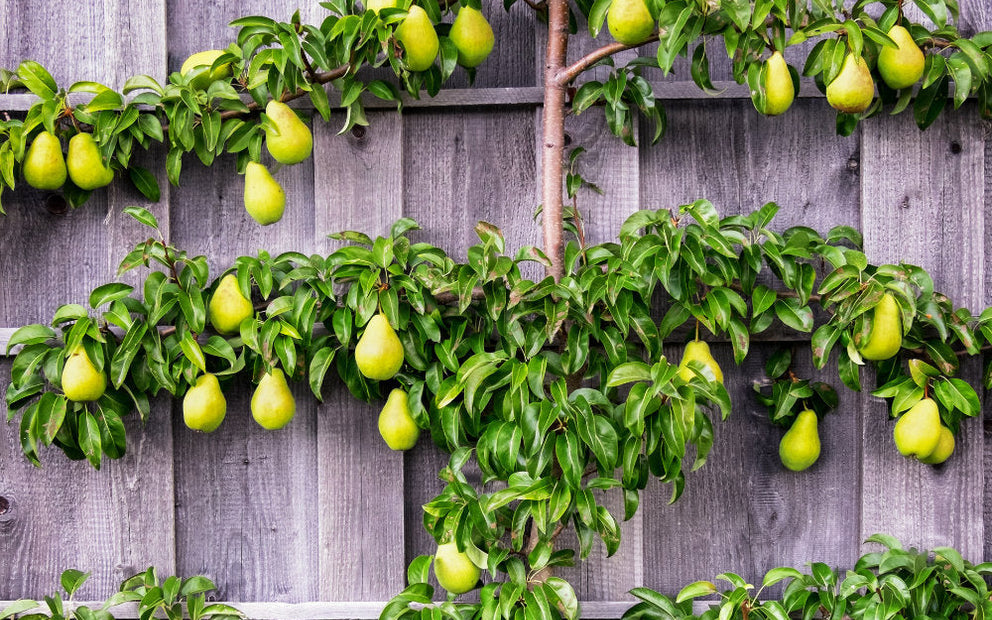Great choice of Pear trees carefully selected by our horticultural experts and ideal for eating fresh or adding to homemade pies and crumbles. We also stock family pear trees which have two or three different varieties grafted onto one tree, making them self-fertile and a great option when you only have room for one tree!
...
Choosing Pear Trees
This section contains many pear varieties, from sweet or rosewater flavoured eating pears to firm cooking pears. For sweetness, Beth is an excellent variety, whilst for hints of rosewater then Beurre Hardy and Conference are good choices. Black Worcester is excellent for cooking. For colourful red pears, choose Red Williams. Please note we stock ornamental Pyrus trees if you want a purely ornamental tree.
The geographical location and planting site may impact your choice of variety and rootstock. Whilst most neighbourhoods have other pear trees that will be used by insects for pollination, if you live in a remote location and are only planting one pear tree then we recommend a self-fertile variety or family pear tree.
Pear trees need a sunny position, but if full sun cannot be provided then Williams Bon Chretien is your best bet for producing fruit. The final height and spread depends on a combination of the variety and the rootstock it is grafted onto, so we offer most varieties on a choice of rootstocks. If space is limited, a dwarf rootstock such as Quince C is recommended.
Growing Pear Trees
Choose a sunny location protected from strong winds to plant your pear tree. If planting multiple pear trees, space them out according to their rootstock. A semi-vigorous Quince A rootstock requires 3 metres between trees, whereas a dwarf Quince C rootstock only requires 2 metres. A square shaped planting hole will help prevent the root spiraling round and constricting each other.
Harvesting Pear Trees
As pears ripen from the inside, you cannot tell from the skin if they are ready to eat or not. Instead, use the ‘check the neck’ technique. Gently squeeze the neck of the pear and if it yields it is ready to eat. If not, leave a little longer and check again in a day or so. Pears ripen at room temperature but will ripen even faster when placed next to bananas in a fruit bowl.
History & Uses of Pear Trees
The name pear is thought to date back to the Aramaic word pira meaning fruit. Pear fruits can be traced back to pre-historic times with pears cropping up in historical documents, including Roman recipes for spiced, stewed pear. It is believed that pears have been cultivated in China for 3000 years and even today China produces the most pears in the world.
Many place names include the word perry which indicates that the area used to produce pear trees. Perry is also the name given to cider made from pears. As well as the more traditional culinary uses involving the fruit, the wood can be used to smoke meats as it gives a good aroma. Another use is making high quality woodwind instruments and furniture from the wood. The wood is also used for making kitchen utensils, such as spoons, ladles and stirrers as it can withstands multiple washes without warping and does not contaminate food with its smell, colour or flavour.
Shop by Fruit
-
-
-
-
-
-
-
-
Regular price £75Sale price £75 Regular priceUnit price per
£75 -
Regular price £60Sale price £60 Regular priceUnit price per
£60 -
BRINGING LIFE TO GARDENS SINCE 2004
Why Ornamental Trees?
Decades of Experience
Based in the beautiful Yorkshire countryside, we have over 20 years of experience and have grown into one of the UK's leading online tree and plant suppliers.
Diverse Selection for Every Garden
From small urban spaces and patios to large country estates, our extensive range of over 900 plant varieties ensures there’s a perfect match for every garden.
Exceptional Quality You Can Trust
Our plants are expertly grown and maintained to ensure they thrive for years to come once they find their permanent homes. We'll never send out a plant we're not entirely happy with!


LET US BE YOUR FIELD-GUIDE






























